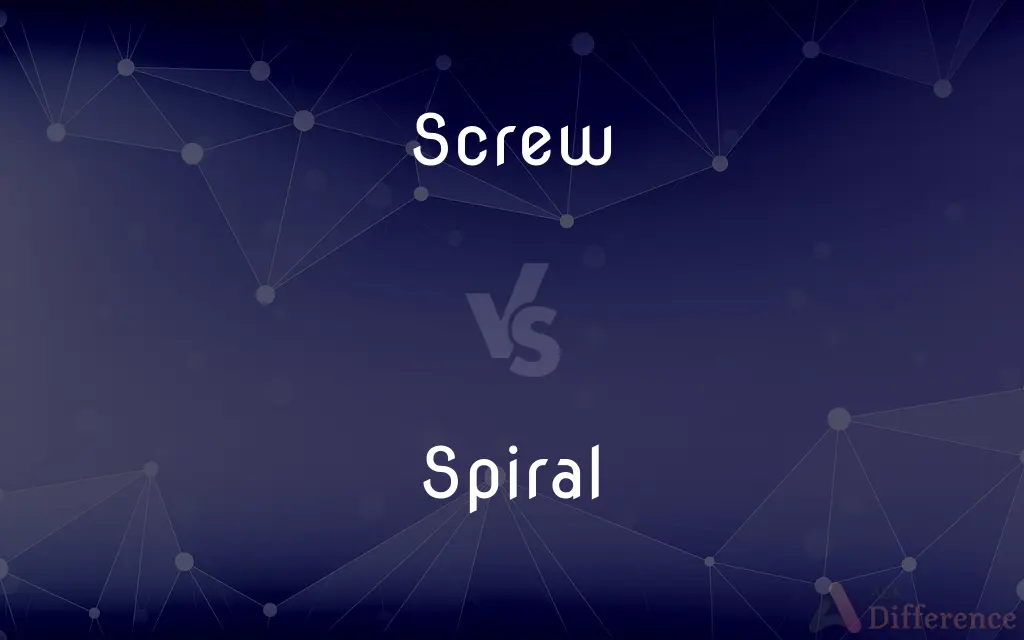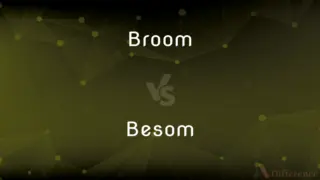Screw vs. Spiral — What's the Difference?
By Tayyaba Rehman & Fiza Rafique — Updated on April 2, 2024
A screw is a type of fastener with a helical ridge, while a spiral is a curve that winds around a fixed center point at a continuously increasing or decreasing distance.

Difference Between Screw and Spiral
Table of Contents
ADVERTISEMENT
Key Differences
Screws are integral to construction and manufacturing, designed primarily to hold objects together or to position them. They work by converting rotational force into linear motion, driven into materials via the helical ridge or thread. On the other hand, a spiral is a geometrical figure that can be found in nature, art, and mathematics, characterized by its continuous curve around a central point.
The design of a screw allows for tight assembly and disassembly, making it a fundamental component in mechanical and construction projects. The threads of a screw create a locking mechanism that is efficient for fastening materials together. Spirals, whereas, do not serve a fastening purpose but are often observed in patterns of growth and movement, such as in shells, galaxies, and weather patterns.
Screws are categorized by their thread design, head shape, and the type of driver needed for installation, making them highly versatile for specific applications. Spirals, on the other hand, are described by their curvature and expansion rate, such as in the Fibonacci spiral, which is a specific type of spiral that appears frequently in nature.
Materials play a critical role in the functionality of screws, with metal, plastic, and wood being common choices, depending on the application. Spirals, however, transcend materiality, occurring as abstract forms in various contexts, from architecture to the arrangement of DNA.
While screws are tangible objects with a practical application in fastening, spirals represent a concept or pattern that can manifest visually in physical objects or abstractly in mathematical theories. This distinction underscores the utilitarian nature of screws versus the often aesthetic or theoretical nature of spirals.
ADVERTISEMENT
Comparison Chart
Definition
A fastener with a helical ridge, used for holding objects together.
A curve that winds around a center point at a continuously varying distance.
Purpose
To fasten or position objects.
Represents growth, movement, or patterns in nature and mathematics.
Characteristics
Threaded design, specific head shapes, made of metal, plastic, or wood.
Described by curvature and expansion rate, material-independent.
Application
Construction, mechanical devices, and DIY projects.
Found in nature, art, mathematics, and architecture.
Representation
Tangible, with a practical utility.
Abstract, representing concepts or patterns.
Compare with Definitions
Screw
Often made of metal or plastic, screws are chosen based on the material they will bind.
For outdoor projects, stainless steel screws are preferred for their rust resistance.
Spiral
Spirals can be found in nature, art, and mathematics, symbolizing growth and continuity.
The spiral galaxy's arms wind outward from its core.
Screw
Screws come in various types, including wood screws, machine screws, and self-tapping screws, each designed for specific applications.
Machine screws are used to assemble metal parts with pre-threaded holes.
Spiral
A curve that emanates from a central point, getting progressively farther away as it revolves around the point.
The nautilus shell displays a perfect natural spiral.
Screw
A fastener with a helical groove and a slotted head, designed to be inserted into materials to hold them together.
The carpenter used a screw to secure the hinges to the door.
Spiral
Can form naturally or be created deliberately in various mediums.
The potter etched a spiral design into the clay vase.
Screw
Requires a tool like a screwdriver or drill for driving into materials.
She used a drill to quickly drive the screws into the wooden frame.
Spiral
Represents mathematical concepts such as the Fibonacci sequence or golden spiral.
Artists use the golden spiral to achieve pleasing proportions in their work.
Screw
They convert rotational motion into linear motion to fasten materials tightly.
Tightening the screw created a strong joint between the two pieces of wood.
Spiral
Often symbolizes expansion, evolution, or eternity in philosophical or artistic contexts.
The spiral staircase symbolized the character's ascent to enlightenment.
Screw
A screw and a bolt (see Differentiation between bolt and screw below) are similar types of fastener typically made of metal and characterized by a helical ridge, called a male thread (external thread). Screws and bolts are used to fasten materials by the engagement of the screw thread with a similar female thread (internal thread) in the matching part.
Spiral
In mathematics, a spiral is a curve which emanates from a point, moving farther away as it revolves around the point.
Screw
A cylindrical rod incised with one or more helical or advancing spiral threads, as a lead screw or worm screw.
Spiral
A curve on a plane that winds around a fixed center point at a continuously increasing or decreasing distance from the point.
Screw
The tapped collar or socket that receives this rod.
Spiral
A three-dimensional curve that turns around an axis at a constant or continuously varying distance while moving parallel to the axis; a helix.
Screw
A tapered and pointed wood screw.
Spiral
Something having the form of such a curve
A spiral of black smoke.
Screw
A cylindrical and flat-tipped machine screw.
Spiral
(Printing) A spiral binding.
Screw
A device having a helical form, such as a corkscrew.
Spiral
The course or flight path of an object rotating on its longitudinal axis.
Screw
A propeller.
Spiral
A continuously accelerating increase or decrease
The wage-price spiral.
Screw
A twist or turn, as of a screw.
Spiral
Of or resembling a spiral.
Screw
A prison guard.
Spiral
Circling around a center at a continuously increasing or decreasing distance.
Screw
The turnkey of a jail.
Spiral
Coiling around an axis in a constantly changing series of planes; helical.
Screw
Salary; wages.
Spiral
(Printing) Relating to or having a spiral binding
A spiral notebook.
Screw
A small paper packet, as of tobacco.
Spiral
To take a spiral form or course.
Screw
An old broken-down horse.
Spiral
To rise or fall with steady acceleration.
Screw
A stingy or crafty bargainer.
Spiral
To cause to take a spiral form or course.
Screw
To drive or tighten (a screw).
Spiral
(geometry) A curve that is the locus of a point that rotates about a fixed point while continuously increasing its distance from that point. Category:en:Curves
Screw
To fasten, tighten, or attach by means of a screw or similar fastener.
Spiral
(informal) A helix.
Screw
To attach (a tapped or threaded fitting or cap) by twisting into place.
Spiral
A self-sustaining process with a lot of momentum involved, so it is difficult to accelerate or stop it at once.
Screw
To rotate (a part) on a threaded axis.
Spiral
(rail) A section of track that forms a circle and crosses over itself, used for gaining height in mountainous territory.
Screw
To contort (one's face).
Spiral
Helical, like a spiral.
Screw
(Slang) To treat (someone) unfairly; exploit or cheat
Screwed me out of the most lucrative sales territory.
Spiral
(intransitive) To move along the path of a spiral or helix.
Screw
To turn or twist.
Spiral
(transitive) To cause something to spiral.
Screw
To become attached by means of the threads of a screw.
Spiral
To increase continually.
Screw
To be capable of such attachment.
Spiral
Winding or circling round a center or pole and gradually receding from it; as, the spiral curve of a watch spring.
Screw
A device that has a helical function.
Spiral
Winding round a cylinder or imaginary axis, and at the same time rising or advancing forward; winding like the thread of a screw; helical.
Screw
A simple machine, a helical inclined plane.
Spiral
Of or pertaining to a spiral; like a spiral.
Screw
A (usually) metal fastener consisting of a partially or completely threaded shank, sometimes with a threaded point, and a head used to both hold the top material and to drive the screw either directly into a soft material or into a prepared hole.
Spiral
A plane curve, not reëntrant, described by a point, called the generatrix, moving along a straight line according to a mathematical law, while the line is revolving about a fixed point called the pole. Cf. Helix.
Screw
(nautical) A ship's propeller.
Spiral
Anything which has a spiral form, as a spiral shell.
Screw
An Archimedes screw.
Spiral
A plane curve traced by a point circling about the center but at ever-greater distances from it
Screw
A steam vessel propelled by a screw instead of wheels.
Spiral
A curve that lies on the surface of a cylinder or cone and cuts the element at a constant angle
Screw
The motion of screwing something; a turn or twist to one side.
Spiral
Ornament consisting of a curve on a plane that winds around a center with an increasing distance from the center
Screw
A prison guard.
Spiral
A structure consisting of something wound in a continuous series of loops;
A coil of rope
Screw
An extortioner; a sharp bargainer; a skinflint.
Spiral
Flying downward in a helical path with a large radius
Screw
An instructor who examines with great or unnecessary severity; also, a searching or strict examination of a student by an instructor.
Spiral
To wind or move in a spiral course;
The muscles and nerves of his fine drawn body were coiling for action
Black smoke coiling up into the sky
The young people gyrated on the dance floor
Screw
(slang) Salary, wages.
Spiral
Form a spiral;
The path spirals up the mountain
Screw
(billiards) Backspin.
Spiral
Move in a spiral or zigzag course
Screw
(slang) A small packet of tobacco.
Spiral
In the shape of a coil
Screw
(dated) An old, worn-out, unsound and worthless horse.
Screw
(math) A straight line in space with which a definite linear magnitude termed the pitch is associated. It is used to express the displacement of a rigid body, which may always be made to consist of a rotation about an axis combined with a translation parallel to that axis.
Screw
An amphipod crustacean.
The skeleton screw (Caprella)
The sand screw
Screw
Rheumatism.
Screw
(transitive) To connect or assemble pieces using a screw.
Screw
To cheat someone or ruin their chances in a game or other situation.
Screw
(transitive) To extort or practice extortion upon; to oppress by unreasonable or extortionate exactions; to put the screws on.
Screw
(transitive) To contort.
Screw
To miskick (a ball) by hitting it with the wrong part of the foot.
Screw
To screw back.
Screw
To examine (a student) rigidly; to subject to a severe examination.
Screw
To leave; to go away; to scram.
Screw
A cylinder, or a cylindrical perforation, having a continuous rib, called the thread, winding round it spirally at a constant inclination, so as to leave a continuous spiral groove between one turn and the next, - used chiefly for producing, when revolved, motion or pressure in the direction of its axis, by the sliding of the threads of the cylinder in the grooves between the threads of the perforation adapted to it, the former being distinguished as the external, or male screw, or, more usually the screw; the latter as the internal, or female screw, or, more usually, the nut.
Screw
Specifically, a kind of nail with a spiral thread and a head with a nick to receive the end of the screw-driver. Screws are much used to hold together pieces of wood or to fasten something; - called also wood screws, and screw nails. See also Screw bolt, below.
Screw
Anything shaped or acting like a screw; esp., a form of wheel for propelling steam vessels. It is placed at the stern, and furnished with blades having helicoidal surfaces to act against the water in the manner of a screw. See Screw propeller, below.
Screw
A steam vesel propelled by a screw instead of wheels; a screw steamer; a propeller.
Screw
An extortioner; a sharp bargainer; a skinflint; a niggard.
Screw
An instructor who examines with great or unnecessary severity; also, a searching or strict examination of a student by an instructor.
Screw
A small packet of tobacco.
Screw
An unsound or worn-out horse, useful as a hack, and commonly of good appearance.
Screw
A straight line in space with which a definite linear magnitude termed the pitch is associated (cf. 5th Pitch, 10 (b)). It is used to express the displacement of a rigid body, which may always be made to consist of a rotation about an axis combined with a translation parallel to that axis.
Screw
An amphipod crustacean; as, the skeleton screw (Caprella). See Sand screw, under Sand.
Screw
To turn, as a screw; to apply a screw to; to press, fasten, or make firm, by means of a screw or screws; as, to screw a lock on a door; to screw a press.
Screw
To force; to squeeze; to press, as by screws.
But screw your courage to the sticking place,And we'll not fail.
Screw
Hence: To practice extortion upon; to oppress by unreasonable or extortionate exactions.
Our country landlords, by unmeasurable screwing and racking their tenants, have already reduced the miserable people to a worse condition than the peasants in France.
Screw
To twist; to distort; as, to screw his visage.
He screwed his face into a hardened smile.
Screw
To examine rigidly, as a student; to subject to a severe examination.
Screw
To use violent mans in making exactions; to be oppressive or exacting.
Screw
To turn one's self uneasily with a twisting motion; as, he screws about in his chair.
Screw
Someone who guards prisoners
Screw
A simple machine of the inclined-plane type consisting of a spirally threaded cylindrical rod that engages with a similarly threaded hole
Screw
A propeller with several angled blades that rotates to push against water or air
Screw
A fastener with a tapered threaded shank and a slotted head
Screw
Turn like a screw
Screw
Cause to penetrate, as with a circular motion;
Drive in screws or bolts
Screw
Tighten or fasten by means of screwing motions;
Screw the bottle cap on
Screw
Defeat someone in an expectation through trickery or deceit
Common Curiosities
Can spirals be found in everyday objects?
Yes, spirals can be found in everyday objects, from the design of a staircase to the pattern on a pine cone.
Why are spirals significant in nature?
Spirals are significant in nature as they often represent patterns of growth and evolution, such as in the arrangement of leaves or the shape of galaxies.
How does a spiral differ from a circle?
A spiral is a curve that moves around a central point at an increasing or decreasing distance, while a circle is a closed curve where all points are equidistant from the center.
What materials are screws made from?
Screws are typically made from metal, plastic, or wood, depending on their intended use.
Are all screws metal?
Not all screws are metal; some are made of plastic or wood to suit different applications and materials.
How do spirals appear in architecture?
Spirals appear in architecture in forms such as spiral staircases, arches, and patterns in floor designs, often adding aesthetic value and symbolic meaning.
What is the difference between a screw and a bolt?
A screw is a type of fastener with a helical thread used to assemble materials, typically driven into place. A bolt is a similar fastener that requires a nut to secure it, used for assembling parts with pre-made holes.
What is a screw used for?
A screw is used to hold materials together or to position them, utilizing its helical thread to provide a strong hold.
What mathematical concepts are related to spirals?
Mathematical concepts related to spirals include the Fibonacci sequence and the golden ratio, which describe their growth patterns.
Are there different types of spirals?
Yes, there are different types of spirals, including the Archimedean spiral, logarithmic spiral, and the Fibonacci spiral, each defined by its unique properties.
Do spirals have practical applications?
While spirals often serve aesthetic or symbolic purposes, they also have practical applications in engineering and design, such as in the structure of springs and cooling systems.
How do you choose the right screw for a project?
Choosing the right screw depends on the material to be fastened, the environmental conditions, and the type of force it needs to withstand.
What role does the thread play in a screw's function?
The thread of a screw converts rotational force into linear motion, allowing it to dig into materials and hold them together securely.
Can the concept of a spiral be applied in technology?
Yes, the concept of a spiral is applied in technology in areas like signal processing and the design of compact antennas.
Share Your Discovery

Previous Comparison
Broom vs. Besom
Next Comparison
Receiver vs. TrusteeAuthor Spotlight
Written by
Tayyaba RehmanTayyaba Rehman is a distinguished writer, currently serving as a primary contributor to askdifference.com. As a researcher in semantics and etymology, Tayyaba's passion for the complexity of languages and their distinctions has found a perfect home on the platform. Tayyaba delves into the intricacies of language, distinguishing between commonly confused words and phrases, thereby providing clarity for readers worldwide.
Co-written by
Fiza RafiqueFiza Rafique is a skilled content writer at AskDifference.com, where she meticulously refines and enhances written pieces. Drawing from her vast editorial expertise, Fiza ensures clarity, accuracy, and precision in every article. Passionate about language, she continually seeks to elevate the quality of content for readers worldwide.
















































